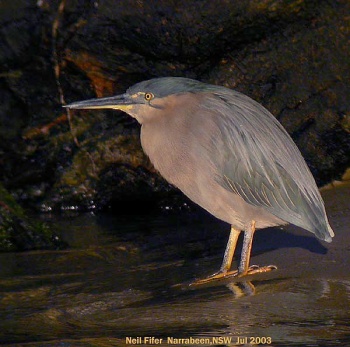- Butorides striatus
Description
L. 35-45 cm (14-18 in)
- Black cap
- Whitish line from central chest to chin
- Whitish line on central underparts is edged and/or mottled rufous in many races.
- Blackish wings with greyish, dull dark greenish or brownish edging
- Belly, flanks, neck and head are greyish in most races
- Brownish in some Australasian subspecies.
- Yellow, bluish, or blackish lores
- Yellowish or reddish legs
- Brighter when breeding
- Yellow eyes
- Black bill
- Often with yellow lower mandible
Juvenile
- Brown
- Whitish-buff streaking on underparts, neck and head
- Spotting on wings
Races
Two Australian races, macrorhynchus and stagnatilis, occurs in a grey and a rufous morph, while the normally grey nominate also occurs in a rare rufous-necked morph (confirmed for Peru and Bolivia; possibly also elsewhere).
Similar Species
Adults are generally distinctive. Rufous-necked morph of nominate race is paler, and has a greyer belly than the Green Heron (limited overlap between the two in coastal Venezuela, Trinidad & Tobago, coastal northern Colombia and eastern Panama).
Possible hybrids between the Striated and the Green showing intermediate plumage have been recorded. Juvenile of Striated, Green and Lava Heron are virtually inseparable.
Distribution
Widespread in sub-Saharan Africa (except far south), warmer parts of Asia, coastal northern and eastern Australia, South America (except far south and the Andes), and islands in the Indian Ocean and Pacific Ocean. See Taxonomy for further information on range. Most races sedentary or with local dispersal only, but two Asian races, amurensis and actophilus, migrate south following breeding.
Taxonomy
Previously placed in the genus Ardeola.
Also know as: Little Heron, Little Green Heron, Green-backed Heron and Mangrove Heron. Sometimes also called the Green Heron, leading to easy confusion with the mainly North American Butorides virescens
Numerous races exist:
- American races:
Nominate (striatus) occurs through most of South America, except for the far south and the Andes. Also in eastern Panama and Trinidad & Tobago.
- African and Middle East races:
B. s. brevipes is found on the Red Sea coasts south to Somalia, atricapillus from the rest of mainland Africa south of the Sahara, rutenbergi from Madagascar, crawfordii on the Aldabra and Amirante Islands, rhizophorae in the Comoros, degens in the Seychelles and javanicus on Reunion, Mauritius, and Rodiguez (this race also in Oriental region, see following).
- Oriental races:
B. s. chloriceps is found in India and Sri Lanka, albolimbatus on Diego Garcia, Chagos Archipelago, and Maldives, javanicus in Burma and Thailand south to the Greater Sundas (this race also in African region, which see), amurensis is found in north-east Asia and northern China (winters in SE Asia south to Sumatra and Philippines), actophilus from southern China to northern Thailand (winters in Sumatra, Borneo, and Nicobar Is.), spodiogaster in Sipura and north Pagai, western Sumatra islands, the Andaman and Nicobar Islands, carcinophilus on Taiwan, the Philippines, and Sulawesi, steini in the Lesser Sundas and moluccarum on the Moluccas.
- Australasian races:
B. s. papuensis occurs in coastal north New Guinea and islands, idenburgi in the interior of north New Guinea, rogersi in coastal Western Australia from Ashburton River to Shark Bay, cinerea from King Sound to De Grey River, Western Australia, stagnatilis from Melville Island to Groote Eylandt and the McArthur River, littleri in coastal north Queensland and southern New Guinea, macrorhynchus from southern Queensland to New South Wales and on New Caledonia and the Loyalty Isles, solomonensis in New Hanover, New Ireland, the Solomon Islands, Santa Cruz, the Torres Islands, Banks Islands, New Hebrides and western Fiji Islands and patruelis in Tahiti, Society Islands.
Often includes the Green Heron and the Galapagos Heron as subspecies.
Habitat
Prefers mangrove and other densely vegetated areas near water (fresh, brackish or salt), but can be seen in a wide range of habitats, e.g. marshes, exposed coral reefs, rice fields and mudflats. Mainly in lowlands, but accidentally as high as 4000 m (13,100 ft).
Behavior
Mainly crespuscular and nocturnal. Territorial.
Diet
Feeds on fishes, crustaceans, insects and other small animals. Has been recorded using insects as bait for attracting fishes.
Breeding
Breeds alone or in small groups (rarely in large colonies). Breeding-season varies. The typically 2-5 eggs are laid in a well-hidden nest placed low in trees, bushes or mangrove.
Discussion
Generally common and widespread. Some localized races are rarer, and it has been estimated that only around 100 individuals remain of the subspecies patruelis.







